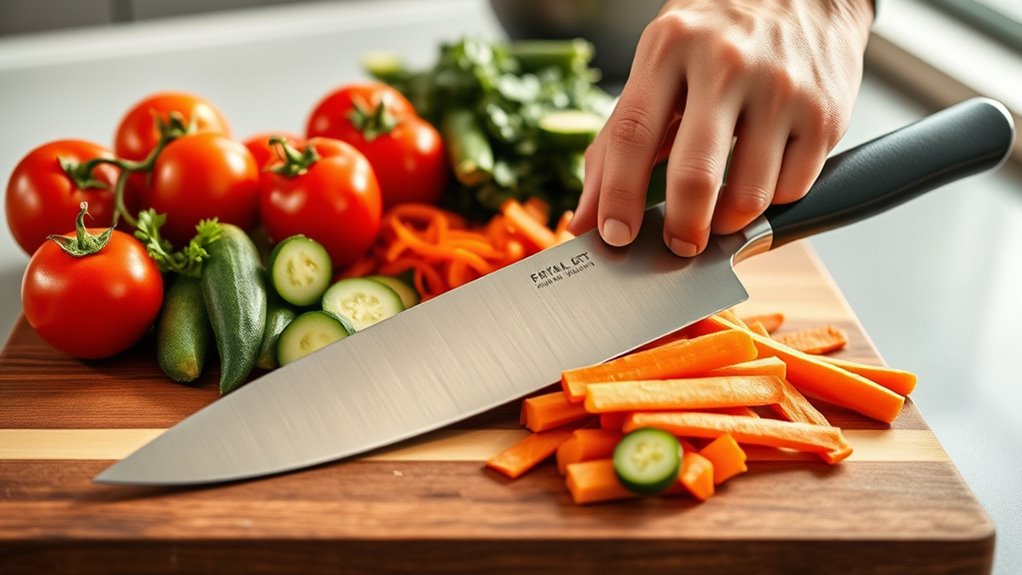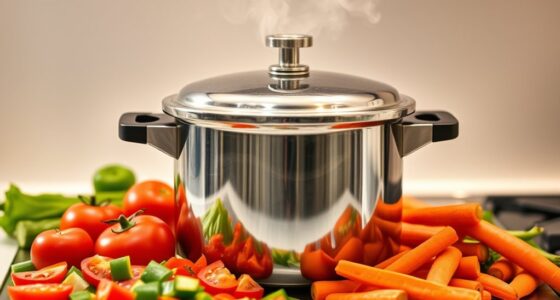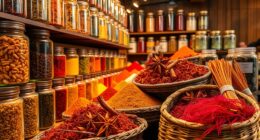To master basic knife skills, start with a sharp, comfortable knife like an 8-10 inch chef’s knife, and hold it with a firm but relaxed grip. Use a claw grip for your non-dominant hand to keep fingers tucked in, and cut away from your body with steady, controlled movements. Practice rocking slices and keep your workspace stable to stay safe. Keep these fundamentals in mind—continue exploring to become more confident in your technique.
Key Takeaways
- Use a sharp, balanced chef’s knife with a secure grip for better control and safety.
- Keep fingers tucked using a claw grip to protect fingertips while cutting.
- Employ a gentle rocking motion, maintaining contact with the cutting board for even slices.
- Always cut away from your body to prevent accidental injuries.
- Maintain a stable workspace with a non-slip surface and organized tools for safer food prep.

Have you ever wondered how professional chefs achieve perfectly sliced vegetables and uniform cuts? The secret lies in mastering basic knife skills, starting with understanding knife safety and choosing the right knives. Knife safety is essential because a sharp, properly handled knife can be safer than a dull one. When you’re cutting, always keep your fingers tucked in, gripping the handle firmly but comfortably. Use a claw grip with your non-dominant hand to hold the food, curling your fingertips inward to prevent accidental cuts. Pay attention to your cutting motion—always cut away from your body and never rush through your prep work. A steady hand and mindful movements help avoid slips and injuries, making your time in the kitchen safer and more efficient. Practicing knife handling techniques can greatly improve both your safety and cutting precision.
Choosing knives might seem overwhelming at first, but selecting the right tools sets the foundation for effective cutting. Start with a versatile chef’s knife, which is typically 8 to 10 inches long and suitable for most tasks like chopping, slicing, and dicing. Look for a knife with a comfortable handle that offers a secure grip and balanced weight, so you don’t tire your hand during extended use. A well-made knife with a full tang—where the blade extends into the handle—provides better control and durability. Don’t forget to consider the blade material; high-carbon stainless steel blades stay sharper longer and resist rust. Investing in good-quality knives initially can make a significant difference in both safety and precision.
Once you’ve chosen the right knives and understand safety basics, practice proper grip techniques. Hold the handle firmly but relaxed, with your index finger and thumb gripping the blade just above the handle for better control. Your other fingers should wrap around the handle comfortably. As you slice, use a smooth, rocking motion, keeping the blade’s tip in contact with the cutting board whenever possible. This technique not only improves your cuts’ consistency but also minimizes strain on your hand and wrist. Remember to keep your workspace organized, with a stable cutting surface and a damp towel underneath the board to prevent slipping.
Frequently Asked Questions
What Is the Safest Way to Store Knives at Home?
To store knives safely at home, use a knife block, magnetic strip, or a drawer insert designed for knives. Always keep blades covered or sheathed to prevent accidental cuts. Follow safety tips like handling knives carefully, avoiding loose storage, and keeping them out of reach of children. Proper knife storage not only protects you but also extends the life of your knives, making your kitchen safer and more organized.
How Often Should I Sharpen My Kitchen Knives?
Like a vintage typewriter, your knives need regular attention. You should sharpen your kitchen knives every 1-2 months if you use them frequently, or when you notice they’re dull. Proper knife maintenance involves consistent sharpening frequency to keep edges sharp, safe, and efficient. Don’t wait until they’re a chore to use—schedule regular honing and sharpening sessions to preserve their performance and extend their lifespan.
Can I Use a Regular Knife for All Tasks?
You can use a regular knife for many tasks, but for ideal knife versatility, it’s better to have task-specific knives. A paring knife excels at detailed work, while a chef’s knife handles chopping and slicing. Using the right knife for each task makes prep easier and safer. While a good quality all-purpose knife works, investing in specialized knives ensures better precision and reduces the risk of damage or injury.
What Type of Cutting Board Is Best for Knife Safety?
Imagine slipping and cutting yourself—that’s why choosing the right cutting board matters. Opt for bamboo or plastic, as they’re gentle on your knives and easy to sanitize, promoting knife safety tips. Avoid glass or ceramic, which can dull blades and cause slips. Your best bet is a sturdy, non-slip cutting board that keeps your knives sharp and your fingers safe, making your prep both safer and more enjoyable.
How Do I Prevent My Knife From Slipping While Cutting?
To prevent your knife from slipping, make sure you have a firm knife grip, keeping your fingers curled and gripping the handle securely. Use a stable cutting surface, like a non-slip cutting board, to prevent movement. Focus on applying controlled, even pressure while cutting, and always cut away from your body. Practicing these techniques helps maintain safety and precision, making your prep work much easier and safer.
Conclusion
Mastering these basic knife skills is like revealing a secret recipe to confident cooking. With every chop and slice, you’ll turn your kitchen into a well-oiled culinary machine. Remember, practice makes perfect, and soon your knife will become an extension of your hand—smooth, precise, and effortless. So, keep honing those skills, and watch your cooking skills grow sharper than ever. Your kitchen adventures are just a cut away from becoming truly delicious!










